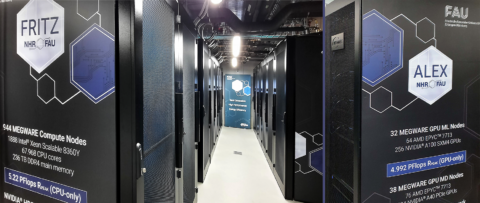A New Era for High Performance Computing in Erlangen
The Top500 and Green500, lists of the fastest and most energy-efficient supercomputers respectively, were published at the ISC High Performance Conference in Hamburg on May 30. We are proud to announce that the new “Fritz” and “Alex” clusters at NHR@FAU have both made it to the Top500 list. In addition, Alex is the most energy efficient compute cluster in Germany.
Even though the design of the new HPC systems was not at all intended for a top spot in the TOP500 list. In order to meet the requirements of researchers at the Friedrich-Alexander-Universität Erlangen-Nürnberg and throughout Germany in the field of atomistic simulations in the best possible and most economical way, the new computers consist of two modules with complementary computer architectures: Alex, a system packed with powerful graphics cards from the company NVIDIA and large local memory, was able to rank 184th in the TOP500 with a LINPACK performance of 2.9 Pflop/s and Fritz, on the other hand, combines the computing power of almost 70,000 Intel CPU cores and is now listed at rank 323.
Dr. Thomas Zeiser from NHR@FAU is responsible for the procurement and operation of the systems. He is particularly pleased that both modules qualified separately for the TOP500 despite the fact that not all resources in both modules could be considered for the current ranking: “On Alex, only the 256 NVIDIA A100 GPGPUs were used to run the LINPACK benchmark; the 304 NVIDIA A40 cards in Alex are optimized for molecular dynamics simulations and cannot run this benchmark effectively. For Fritz, the all too well known supply problems have hit us hard. Although all Intel compute nodes were already installed in December by our system partner MEGWARE, a third of all network cards from NVIDIA are still missing.” Dr. Zeiser is confident that these will be available by the next edition of the lists and that Fritz will then make a further leap in performance from the current 2.2 Pflop/s to over 3 Pflop/s.
In addition, Alex ranked 16th on the Green500 list, which sorts TOP500 supercomputers by energy efficiency. With 26.76 Gflops/W, it achieved the best value in Germany and is ranked 8th in Europe (including the UK). “We are very satisfied that together with MEGWARE and Inspur we have succeeded in defining, installing, and configuring a system that is at the forefront of energy efficiency,” emphasizes Prof. Gerhard Wellein, Director of NHR@FAU.
With all the excellent benchmark values, however, it should not be forgotten that both systems have been used continually by researchers at FAU and from all over Germany since their first power on. Application areas that are already benefitting greatly include molecular dynamics simulations in the field of mRNA vaccine research, studies of DNA repair enzymes, applications in machine learning such as gesture recognition (“Talking with your hands and feet – can a computer understand that?”), or deep unsupervised models for protein design. Of course, the classical applications in high-performance computing in the fields of fluid mechanics and climate research could also be found on the new systems right from the start.
Cluster Alex
- 560 A40/A100 NVIDIA GPGPUs
- Up to 80 GiB RAM per GPU
- Peak performance ≈ 5 PFlops/s (FP64)
- Peak performance ≈ 0.5 ExaOps/s (INT4)
- Power consumption up to 275 kW
Cluster Fritz
- 944 compute nodes
- 67,968 cores (72 cores per node)
- 256 GiB RAM per compute node
- Peak performance ≈ 5 PFlops/s
- Power consumption up to 750 kW
Contact us
- Email: hpc-support@fau.de
Prof. Dr. Gerhard Wellein
Department of Computer Science
Professorship for High Performance Computing
- Phone number: +49913185-28136
- Email: gerhard.wellein@fau.de

